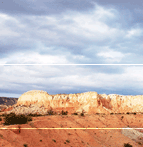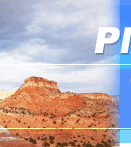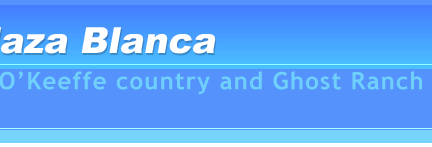Best Time to Visit Plaza Blanca and Abiquiu
The timing of your visit to Plaza Blanca and the surrounding Abiquiu region can dramatically impact your experience. With its high desert climate, dramatic seasonal variations, and unique weather patterns, understanding when to visit ensures comfortable hiking, optimal photography conditions, and the best possible exploration of this remarkable landscape. Each season offers distinct advantages and challenges that savvy travelers can use to their advantage.
Understanding Abiquiu's High Desert Climate
Elevation Impact: At approximately 6,200 feet above sea level, Abiquiu experiences more extreme temperature variations than lower-elevation desert regions. The thin air means rapid heating during sunny days and equally rapid cooling once the sun sets. This elevation also intensifies UV radiation, making sun protection crucial year-round regardless of temperature.
Precipitation Patterns: The region receives only 8-12 inches of annual precipitation, with distinct wet and dry seasons. The summer monsoon season (July-September) brings afternoon thunderstorms, while winter precipitation often falls as snow. Spring and fall are characteristically dry, offering the most predictable weather conditions for outdoor activities.
Spring: March through May - Peak Visiting Season
Why Spring Excels: Spring represents the ideal visiting season for Plaza Blanca, combining comfortable temperatures, minimal precipitation, and stunning wildflower displays. Daytime temperatures range from the pleasant 60s in March to the comfortable 70s in May, while nighttime lows drop into the 30s and 40s. This moderate climate provides perfect conditions for hiking, photography, and extended outdoor exploration.
March Characteristics: Early spring can still feel winter-like with occasional snow possible, especially at higher elevations around Ghost Ranch. However, sunny days are common, and the landscape begins its transformation from winter dormancy. Wildflowers start appearing in protected areas, and wildlife becomes more active. Expect variable weather requiring flexible clothing strategies.
April Advantages: April often provides the most reliable weather of the year, with average highs in the upper 60s and lows in the 40s. Precipitation is minimal, winds are typically light, and the dramatic landscape colors are at their most vibrant. This is considered prime time for photography enthusiasts seeking optimal lighting conditions without extreme weather challenges.
May Magic: Late spring offers warm, comfortable days perfect for extended hiking and exploration. Desert wildflowers reach peak bloom in favorable years, creating spectacular displays against the white limestone formations. However, May can also mark the beginning of warmer temperatures, with highs occasionally reaching the low 80s.
Summer: June through August - Early Morning Adventures
Heat Management Required: Summer brings significant challenges with daytime temperatures regularly exceeding 85°F and occasionally reaching the mid-90s. However, this season also offers unique opportunities for early morning photographers and those comfortable with desert heat. The key to summer success lies in adapting activity schedules and understanding monsoon patterns.
June Transition: Early summer sees increasing temperatures but typically remains dry until mid-month. This can be an excellent time for visitors comfortable with heat who want to avoid crowds. Morning temperatures are still pleasant for hiking, and the longer days provide extended photography opportunities during golden hours.
Monsoon Season (July-August): The summer monsoon brings afternoon and evening thunderstorms that can dramatically change hiking conditions. While these storms provide relief from heat and create spectacular sky displays, they also bring flash flood risks in washes and canyons. Lightning activity makes exposed ridge hiking dangerous during afternoon hours.
Summer Strategy: Successful summer visits require starting activities before dawn and completing exposed hiking by 10 AM. The dramatic afternoon light and storm clouds create extraordinary photographic opportunities, but safety must be the primary consideration. Carry extra water and electrolyte replacement, and always monitor weather forecasts.
Fall: September through November - Return to Excellence
Second Prime Season: Fall rivals spring as the optimal visiting time, offering comfortable temperatures, stable weather patterns, and exceptional clarity for long-distance photography. The monsoon season typically ends in early September, ushering in a period of clear skies and mild temperatures that can last through November.
September Transition: Early fall may still experience occasional monsoon activity, but temperatures begin moderating from summer highs. This transitional period can offer the best of both seasons - warm, comfortable days without extreme heat, and the dramatic skies left over from monsoon activity.
October Perfection: Many consider October the single best month for visiting Plaza Blanca. Daytime temperatures typically range from the comfortable 60s to low 70s, while nighttime lows drop into the 30s and 40s. Clear skies are common, precipitation is minimal, and the crisp air provides exceptional visibility for photography and sightseeing.
November Considerations: Late fall brings cooler temperatures and the possibility of early winter weather. While many days remain pleasant, visitors should be prepared for winter-like conditions, especially at higher elevations. This month often provides excellent hiking conditions for those prepared for variable weather.
Winter: December through February - Solitude and Beauty
Challenging but Rewarding: Winter presents the most challenging visiting conditions but also offers unique rewards for prepared visitors. Snow transforms the red rock landscape into a stunning contrast of white, red, and blue, creating some of the most dramatic photographic opportunities of the year.
Temperature Extremes: Winter daytime temperatures typically range from the 40s to 50s on sunny days, but can remain below freezing during stormy periods. Nighttime lows regularly drop into the teens and occasionally reach single digits. Wind chill can make conditions feel significantly colder.
Snow and Ice Considerations: While snowfall varies significantly from year to year, accumulations of 6-12 inches are common, and occasional storms can bring much larger amounts. Ice on trails and roads creates additional hazards, and access to remote areas may be limited. However, the solitude and dramatic beauty of snow-covered formations can be unparalleled.
Winter Advantages: Crowds are minimal, allowing for peaceful contemplation of the landscape. The low-angle winter sun creates excellent lighting for photography throughout much of the day. Clear winter days offer exceptional air quality and visibility for long-distance views of surrounding mountain ranges.
Monthly Planning Guide
Peak Season Months (April, May, October)
Booking Considerations: These months represent peak visiting times, requiring advance reservations for accommodations and popular activities like Georgia O'Keeffe house tours. Weather is most predictable, making these months ideal for visitors with inflexible schedules.
Shoulder Season Advantages (March, September, November)
Value and Flexibility: Shoulder seasons offer many of the advantages of peak times with potentially lower accommodation costs and fewer crowds. Weather variability requires flexible planning but can provide unique experiences not available during peak periods.
Off-Season Opportunities (December-February, June-August)
Specialized Experiences: Off-season visits require specific preparation and limitations on activities, but offer unique rewards. Winter provides solitude and dramatic snow landscapes, while summer enables early morning adventures and monsoon sky photography.
Special Considerations for Photography
Golden Hour Optimization: The orientation of Plaza Blanca's formations makes morning light particularly spectacular from April through September, while winter's lower sun angle provides excellent lighting throughout much of the day. Photographers should plan around these seasonal light variations.
Weather Drama: Some of the most spectacular photography occurs during transitional weather - clearing storms, snow on red rocks, and dramatic monsoon clouds. These conditions require flexibility and preparedness but can provide once-in-a-lifetime images.
Planning Your Visit Timing
Activity-Based Scheduling: Different activities have optimal seasons. Hiking is best in spring and fall, photography opportunities exist year-round but peak in shoulder seasons, and wildlife viewing is optimal in spring when animals are most active.
Multi-Day Strategy: Visitors planning extended stays should consider arrival during shoulder seasons to take advantage of optimal weather while having flexibility to adapt to changing conditions. The nearby attractions provide alternatives when weather limits access to Plaza Blanca itself.
Emergency Planning: Regardless of season, always monitor current weather forecasts and carry emergency supplies appropriate for conditions. Weather can change rapidly in high desert environments, and preparation can prevent uncomfortable or dangerous situations.
By understanding the unique seasonal characteristics of the Abiquiu region and planning accordingly, visitors can maximize their enjoyment while safely experiencing one of the American Southwest's most remarkable landscapes. Each season offers its own rewards for those prepared to embrace the high desert's dramatic and ever-changing character. the summer months.
During the winter there is snow fall but not ever year.
Plaza Blanca Guide -
How To Get Here -
Unofficial guide. Not associated in any way with the Dar Al Islam
Center or Georgia O'Keeffe's estate
|









